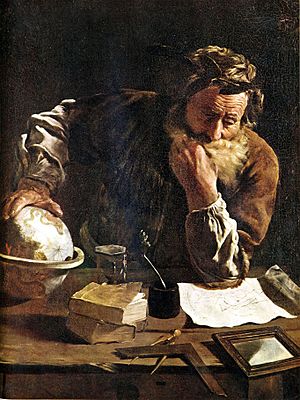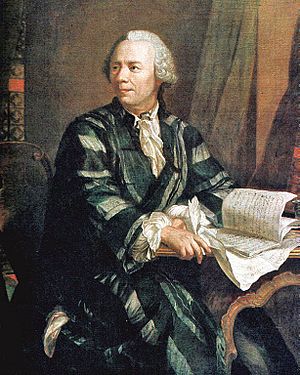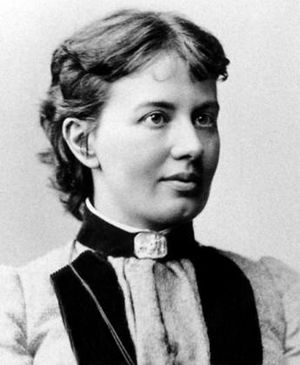Mathematician facts for kids

Euclid (holding calipers), Greek mathematician, known as the "Father of Geometry"
|
|
| Occupation | |
|---|---|
|
Occupation type
|
Academic |
| Description | |
| Competencies | Mathematics, analytical skills and critical thinking skills |
|
Education required
|
Doctoral degree, occasionally master's degree |
|
Fields of
employment |
universities, private corporations, financial industry, government |
|
Related jobs
|
statistician, actuary |
A mathematician is someone who studies mathematics, either as a hobby or as a job. Many mathematicians are math professors at universities. Euclid, Ramanujan, Sir Isaac Newton are some of the most famous early mathematicians.
Mathematics is concerned with numbers, data, quantity, structure, space, models, and change.
Contents
Activities
Applied mathematics
Mathematicians involved with solving problems with applications in real life are called applied mathematicians. Applied mathematicians are mathematical scientists who, with their specialized knowledge and professional methodology, approach many of the imposing problems presented in related scientific fields. With professional focus on a wide variety of problems, theoretical systems, and localized constructs, applied mathematicians work regularly in the study and formulation of mathematical models. Mathematicians and applied mathematicians are considered to be two of the STEM (science, technology, engineering, and mathematics) careers.
The discipline of applied mathematics concerns itself with mathematical methods that are typically used in science, engineering, business, and industry; thus, "applied mathematics" is a mathematical science with specialized knowledge. The term "applied mathematics" also describes the professional specialty in which mathematicians work on problems, often concrete but sometimes abstract. As professionals focused on problem solving, applied mathematicians look into the formulation, study, and use of mathematical models in science, engineering, business, and other areas of mathematical practice.
Abstract mathematics
Pure mathematics is mathematics that studies entirely abstract concepts. From the eighteenth century onwards, this was a recognized category of mathematical activity, sometimes characterized as speculative mathematics, and at variance with the trend towards meeting the needs of navigation, astronomy, physics, economics, engineering, and other applications.
Another insightful view put forth is that pure mathematics is not necessarily applied mathematics: it is possible to study abstract entities with respect to their intrinsic nature, and not be concerned with how they manifest in the real world. Even though the pure and applied viewpoints are distinct philosophical positions, in practice there is much overlap in the activity of pure and applied mathematicians.
To develop accurate models for describing the real world, many applied mathematicians draw on tools and techniques that are often considered to be "pure" mathematics. On the other hand, many pure mathematicians draw on natural and social phenomena as inspiration for their abstract research.
Mathematics teaching
Many professional mathematicians also engage in the teaching of mathematics. Duties may include:
- teaching university mathematics courses;
- supervising undergraduate and graduate research; and
- serving on academic committees.
Consulting
Many careers in mathematics outside of universities involve consulting. For instance, actuaries assemble and analyze data to estimate the probability and likely cost of the occurrence of an event such as death, sickness, injury, disability, or loss of property. Actuaries also address financial questions, including those involving the level of pension contributions required to produce a certain retirement income and the way in which a company should invest resources to maximize its return on investments in light of potential risk. Using their broad knowledge, actuaries help design and price insurance policies, pension plans, and other financial strategies in a manner which will help ensure that the plans are maintained on a sound financial basis.
As another example, mathematical finance will derive and extend the mathematical or numerical models without necessarily establishing a link to financial theory, taking observed market prices as input. Mathematical consistency is required, not compatibility with economic theory. Thus, for example, while a financial economist might study the structural reasons why a company may have a certain share price, a financial mathematician may take the share price as a given, and attempt to use stochastic calculus to obtain the corresponding value of derivatives of the stock.
Occupations
According to the Dictionary of Occupational Titles occupations in mathematics include the following.
- Mathematician
- Operations-Research Analyst
- Mathematical Statistician
- Mathematical Technician
- Actuary
- Applied Statistician
- Weight Analyst
Mathematical societies and foundations
| Acronyms | Name | Headquarters | Initiation |
|---|---|---|---|
| AAS | Australian Academy of Science | Australia | 1954 |
| Abertis | Fundación Abertis | Spain | 1999 |
| ACM | Association for Computing Machinery Special Interest Group | 1947 | |
| AMS | American Mathematical Society | United States | 1888 |
| ANCEFN | Academia Nacional de Ciencias Exactas, Físicas y Naturales | Argentina | 1874 |
| ANCYT | Academia Nacional de Ciencia y Tecnología | Peru | |
| ANTS | Algorithmic Number Theory Symposium | Germany | 1994 |
| APS | American Physical Society | United States | 1889 |
| APSF | Alfred Pritchard Sloan Foundation | United States | 1875 |
| ASA | American Statistical Association | United States | 1839 |
| ASF | Académie des Sciences | France | 1666 |
| ASL | Association for Symbolic Logic | United States | 1936 |
| AWM | Association for Women in Mathematics | United States | 1971 |
| ASME | American Society Of Mechanical Engineers | United States | 1880 |
| AustMS | Australian Mathematical Society | Australia | 1956 |
| BMG | Berliner Mathematischen Gesellschaft | Germany | 1901 |
| BMS | Belgian Mathematical Society | Belgium | 1921 |
| CIMAT | Centro de Investigación en Matemáticas, A.C. | Mexico | 1980 |
| CMF | Fundación Chern | United States | 2010 |
| CMI | Clay Mathematics Institute | United States | 1998 |
| CMS | Canadian Mathematical Society | Canada | 1945 |
| CNCA | Consejo Nacional de la Cultura y las Artes de Chile | Chile | 2003 |
| CNRS | Centre national de la recherche scientifique | France | 1939 |
| CONICIT | Consejo Nacional para Investigaciones Científicas y Tecnológicas | San Jose Costa Rica | 1972 |
| CRM | Centre de Recherches Mathematiques | Canada | 1968 |
| CSIC | Consejo Superior de Investigaciones Científicas | Spain | 1998 |
| DMV | Deutsche Mathematiker-Vereinigung | Germany | 1993 |
| ECM | European Congresses of Mathematics | Poland | 1992 |
| ECCOMAS | European Community on Computational Methods in Applied Sciences and Engineering | Europe | 1901 |
| EMS | European Mathematical Society | Germany | |
| EPFL | École polytechnique fédérale de Lausanne | Switzerland | |
| ERC,CEI | European Research Council | Europe | 2002 |
| ESF | Fundación Europea de la Ciencia | Europe | |
| ETHZ | Eidgenossische Technische Hochschule-Zurich | Switzerland | |
| FBBVA | Fundación BBVA | Spain | |
| FCFM | Facultad de Ciencias Físicas y Matemáticas, Universidad de Chile | Chile | 1840 |
| FCRI | Fundació Catalana per a la Recerca i la Innovació | Spain | |
| FPA | Fundación Príncipe de Asturias | Spain | 1980 |
| FSK | Fundación Sofía Kovalévskaia | Mexico | 1942 |
| GAMNI | Groupe pour l’Avancement des Méthodes Numériques de l’Ingénieur | France | 1992 |
| GenCat | Generalitat de Catalunya | Spain | |
| HAS | Hungarian Academy of Sciences | Hungary | 1825 |
| IAMP | International Association of Mathematical Physics | Europe | 1976 |
| ICA | Institute Of Combinatorics And Its Applications | Canada | 1990 |
| ICMAT | Instituto de Ciencias Matemáticas | Spain | 2008 |
| ICHM | International Commission on the History of Mathematics | United States | 1971 |
| ICIAM | International Council for Industrial and Applied Mathematics | United States | 1987 |
| ICM | International Congress of Mathematicians | ||
| ICMI | International Commission on Mathematical Instruction | 1897 | |
| ICTCM | International Conference on Technology in Collegiate Mathematics | ||
| ICTP | Abdus Salam International Centre for Theoretical Physics | Italy | 1964 |
| IEC | Institvt d'Estvdis Catalans | Spain | 1907 |
| IEEE-CS | IEEE Computer Society | United States | 1946 |
| IMA | Institute of Mathematics and its Applications | England | 1964 |
| IMAFF | Instituto de Matemáticas y Física Fundamental | Spain | |
| IMT | Institut de Mathématiques de Toulouse | France | 1887 |
| IMU | International Mathematical Union | Germany | 1920 |
| INFORMS | Institute for Operations Research and the Management Sciences | United States | |
| ISDE | International Society of Difference Equations | ||
| Konex | Fundación Konex | Argentina | 1980 |
| KVA | Swedish Royal Academies | Sweden | 1739 |
| LMS | London Mathematical Society | England | 1865 |
| MAA | Mathematical Association of America | United States | 1915 |
| MEC | Ministerio de Educación y Ciencia de Spain | Spain | |
| MFO | Mathematisches Forschungsinstitut Oberwolfach | Germany | 1944 |
| MICIT | Ministerio de Ciencia y Tecnología | San José Costa Rica | |
| MOS | Mathematical Optimization Society | 1973 | |
| MSJ | Mathematical Society of Japan | Japan | 1946 |
| NAS | National Academy of Sciences | United States | 1974 |
| NFT | Number Theory Foundation | United States | |
| NUST | National University of Sciences and Technology | Pakistan | 1991 |
| ÖMG | Österreichische Mathematische Gesellschaft | Austria | 1903 |
| PIMS | Pacific Institute for the Mathematical Sciences | Canada | 1996 |
| RAS | Russian Academy of Sciences | Russia | 1724 |
| RSC | Royal Society of Canada | Canada | 1882 |
| RSL | Royal Society of London | England | 1660 |
| RSME | Real Sociedad Matemática Española | Spain | |
| RSS | Royal Statistical Society | England | 1834 |
| SASTRA | Shanmugha Arts, Science, Technology & Research Academy | India | 1984 |
| SCM | Societat Catalana de Matemàtiques | Spain | 1998 |
| SEMA | Sociedad Española de Matemática Aplicada | Spain | 1991 |
| SEP | Secretaría de educación pública | Mexico | |
| SIAG | SIAM Activity Group | United States | |
| SIAM | Society for Industrial and Applied Mathematics | United States | 1951 |
| SIMAI | Società Italiana di Matematica Applicata e Industriale | Italy | 1989 |
| SMAI | Lisez maintenant Société de mathématiques appliquées et industrielles | France | 1983 |
| SMF | Société Mathématique de France | France | 1872 |
| SMM | Sociedad Matemática Mexicana | Mexico | 1943 |
| SPB | Saint Petersburg Mathematical Society | Russia | 1890 |
| UMALCA | Unión Matemática de América Latina y el Caribe | Latin America | 1995 |
| UMI | Unione Matematica Italiana | Italy | 1922 |
| WFNMC | World Federation of National Mathematics Competitions | 1984 |
Images for kids
-
Emmy Noether, mathematical theorist and teacher
See also
 In Spanish: Matemático para niños
In Spanish: Matemático para niños






